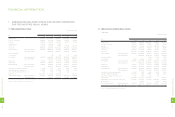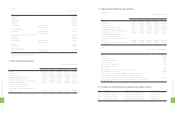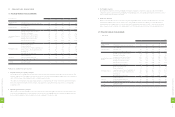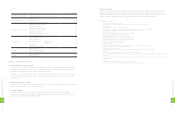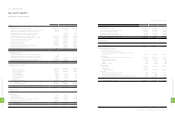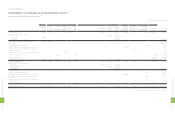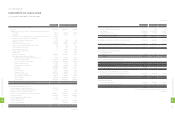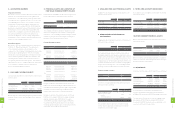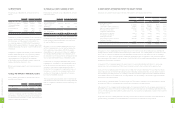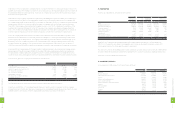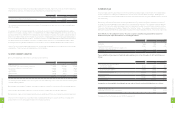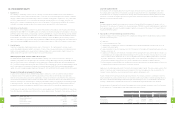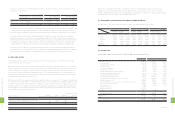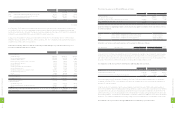HTC 2012 Annual Report Download - page 82
Download and view the complete annual report
Please find page 82 of the 2012 HTC annual report below. You can navigate through the pages in the report by either clicking on the pages listed below, or by using the keyword search tool below to find specific information within the annual report.
loss on purchase order, bonuses to employees, etc.
Actual results may differ from these estimates.
(3) Current/Non-current Assets and Liabilities
Current assets include cash, cash equivalents, and
those assets held primarily for trading purposes or
to be realized, sold or consumed within one year
from the balance sheet date. All other assets such as
properties and intangible assets are classified as non-
current. Current liabilities are obligations incurred
for trading purposes or to be settled within one year
from the balance sheet date. All other liabilities are
classified as non-current.
(4) Financial Assets/Liabilities at Fair Value
through Profit or Loss
Financial instruments classified as financial assets
or financial liabilities at fair value through profit or
loss ("FVTPL") include financial assets or financial
liabilities held for trading and those designated
as at FVTPL on initial recognition. The Company
recognizes a financial asset or a financial liability on
its balance sheet when the Company becomes a
party to the contractual provisions of the financial
instrument. A financial asset is derecognized when
the Company has lost control of its contractual
rights over the financial asset. A financial liability is
derecognized when the obligation specified in the
relevant contract is discharged, canceled or expired.
Financial instruments at FVTPL are initially measured
at fair value plus transaction costs that are directly
attributable to the acquisition. At each balance sheet
date subsequent to initial recognition, financial assets
or financial liabilities at FVTPL are remeasured at fair
value, with changes in fair value recognized directly
in profit or loss in the year in which they arise. Cash
dividends received (including those received in the
year of investment) are recognized as income for
the year. On derecognition of a financial asset or a
financial liability, the difference between its carrying
amount and the sum of the consideration received
and receivable or consideration paid and payable is
recognized in profit or loss. All regular way purchases
or sales of financial assets are recognized and
derecognized on a trade date basis.
A derivative that does not meet the criteria for
hedge accounting is classified as a financial asset or
a financial liability held for trading. If the fair value of
the derivative is positive, the derivative is recognized
as a financial asset; otherwise, the derivative is
recognized as a financial liability.
Fair values of financial assets and financial liabilities
at the balance sheet date are determined as follows:
publicly traded stocks - at closing prices; open-end
mutual funds - at net asset values; bonds - at prices
quoted by the Taiwan GreTai Securities Market; and
financial assets and financial liabilities without quoted
prices in an active market - at values determined using
valuation techniques.
(5) Available-for-sale Financial Assets
Available-for-sale financial assets are initially measured
at fair value plus transaction costs that are directly
attributable to the acquisition. At each balance sheet
date subsequent to initial recognition, available-for-
sale financial assets are remeasured at fair value, with
changes in fair value recognized in equity until the
financial assets are disposed of, at which time, the
cumulative gain or loss previously recognized in equity
is included in profit or loss for the year. All regular way
purchases or sales of financial assets are recognized
and derecognized on a trade date basis.
The recognition, derecognition and the fair value bases
of available-for-sale financial assets are similar to those
of financial assets at FVTPL.
Cash dividends are recognized upon the stockholders'
resolutions, except for dividends distributed from the
pre-acquisition profit, which are treated as a reduction
of investment cost. Stock dividends are not recognized
as investment income but are recorded as an increase
in the number of shares. The total number of shares
subsequent to the increase is used for the recalculation
of cost per share.
An impairment loss is recognized when there is
objective evidence that the financial asset is impaired.
Any subsequent decrease in impairment loss on an
equity instrument classified as available-for-sale is
recognized directly in equity.
(6) Revenue Recognition, Accounts Receivable and
Allowance for Doubtful Accounts
Revenue from sales of goods is recognized when the
Company has transferred to the buyer the significant
risks and rewards of ownership of the goods, primarily
upon shipment, because the earnings process has been
completed and the economic benefits associated with
the transaction have been realized or are realizable.
The Company does not recognize sales revenue on
materials delivered to subcontractors because this
delivery does not involve a transfer of risks and rewards
of materials ownership.
HTC CORPORATION
NOTES TO FINANCIAL STATEMENTS
Years Ended December 31, 2011 and 2012
(In Thousands, Unless Stated Otherwise)
1. ORGANIZATION AND OPERATIONS
HTC Corporation (the "Company") was incorporated on May
15, 1997 under the Company Law of the Republic of China
to design, manufacture, assemble, process, and sell smart
handheld devices and provide after-sales service. In March
2002, the Company’s stock was listed on the Taiwan Stock
Exchange. On November 19, 2003, the Company listed some
of its shares of stock on the Luxembourg Stock Exchange in
the form of global depositary receipts.
The Company had 14,506 and 14,252 employees as of
December 31, 2011 and 2012, respectively.
2. SIGNIFICANT ACCOUNTING POLICIES
The financial statements have been prepared in conformity with
the Guidelines Governing the Preparation of Financial Reports
by Securities Issuers, Business Accounting Law, Guidelines
Governing Business Accounting, and accounting principles
generally accepted in the Republic of China ("ROC").
For readers' convenience, the accompanying financial
statements have been translated into English from the original
Chinese version prepared and used in the ROC. If inconsistencies
arise between the English version and the Chinese version or if
differences arise in the interpretations between the two versions,
the Chinese version of the financial statements shall prevail.
However, the accompanying financial statements do not include
the English translation of the additional footnote disclosures
that are not required under ROC generally accepted accounting
principles but are required by the Securities and Futures Bureau
for their oversight purposes.
Significant accounting policies are summarized as follows:
(1) Foreign Currencies
The financial statements of foreign operations are
translated into New Taiwan dollars at the following
exchange rates:
a. Assets and liabilities - at exchange rates prevailing on
the balance sheet date;
b. Stockholders' equity - at historical exchange rates;
c. Dividends - at the exchange rate prevailing on the
dividend declaration date; and
d. Income and expenses - at average exchange rates
for the year.
Exchange differences arising from the translation of
the financial statements of foreign operations are
recognized as a separate component of stockholders'
equity. These exchange differences are recognized as
gain or loss in the year in which the foreign operations
are disposed of.
Non-derivative foreign-currency transactions are
recorded in New Taiwan dollars at the rates of
exchange in effect when the transactions occur.
Exchange differences arising from the settlement of
foreign-currency assets and liabilities are recognized as
gain or loss.
At the balance sheet date, foreign-currency monetary
assets and liabilities are revalued using prevailing
exchange rates and the exchange differences are
recognized in profit or loss.
At the balance sheet date, foreign-currency non-
monetary assets (such as equity instruments) and
liabilities that are measured at fair value are revalued
using prevailing exchange rates, with the exchange
differences treated as follows:
a. Recognized in stockholders' equity if the changes in
fair value are recognized in stockholders' equity; and
b. Recognized in profit and loss if the changes in fair
value is recognized in profit or loss.
Foreign-currency non-monetary assets and liabilities
that are carried at cost continue to be stated at
exchange rates at the trade dates.
If the functional currency of an equity-method
investee is a foreign currency, translation
adjustments will result from the translation of the
investee's financial statements into the reporting
currency of the Company. These adjustments are
accumulated and reported as a separate component
of stockholders' equity.
(2) Accounting Estimates
Under the above guidelines, law and principles, certain
estimates and assumptions have been used for the
allowance for doubtful accounts, allowance for loss
on inventories, depreciation of properties, marketing
expenses, income tax, royalty, pension cost, loss on
pending litigations, product warranties, contingent
1
6
0
8
FINANCIAL INFORMATION
1
6
1
8
FINANCIAL INFORMATION


